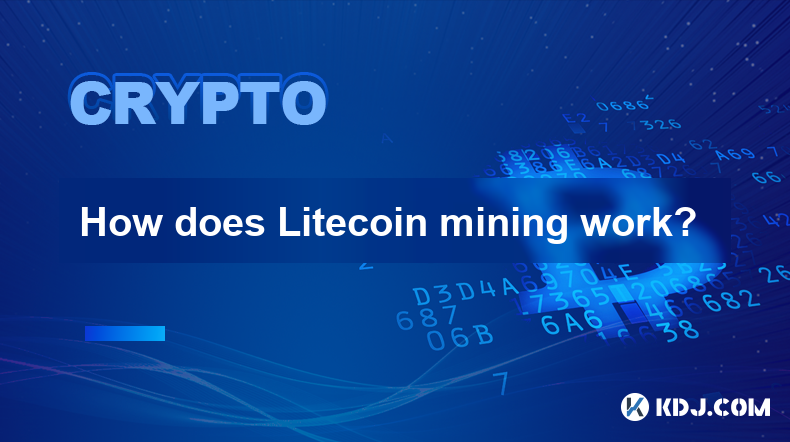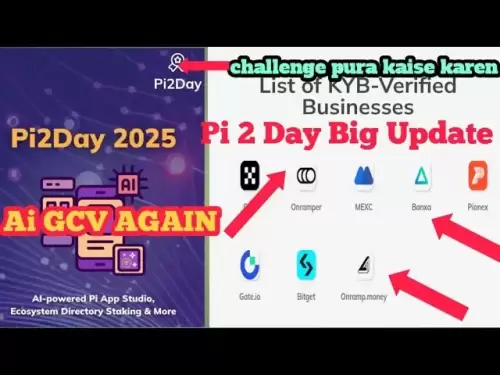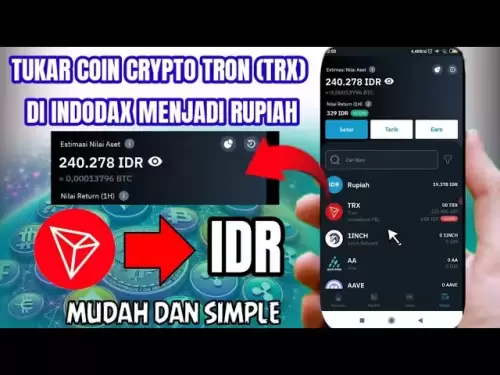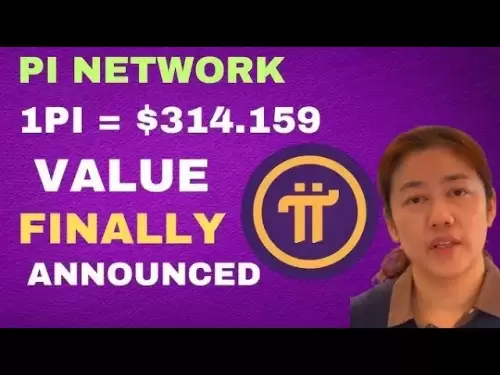-
 Bitcoin
Bitcoin $108,489.6704
1.13% -
 Ethereum
Ethereum $2,502.0528
2.92% -
 Tether USDt
Tether USDt $1.0002
0.00% -
 XRP
XRP $2.1941
0.51% -
 BNB
BNB $655.3375
1.00% -
 Solana
Solana $151.5977
1.27% -
 USDC
USDC $0.9999
0.00% -
 TRON
TRON $0.2768
0.32% -
 Dogecoin
Dogecoin $0.1676
2.86% -
 Cardano
Cardano $0.5675
0.98% -
 Hyperliquid
Hyperliquid $40.6109
7.48% -
 Bitcoin Cash
Bitcoin Cash $500.7746
2.09% -
 Sui
Sui $2.8328
2.03% -
 Chainlink
Chainlink $13.4452
1.26% -
 UNUS SED LEO
UNUS SED LEO $9.1623
0.39% -
 Avalanche
Avalanche $18.2267
2.24% -
 Stellar
Stellar $0.2382
0.00% -
 Toncoin
Toncoin $2.8885
1.68% -
 Shiba Inu
Shiba Inu $0.0...01159
0.91% -
 Litecoin
Litecoin $87.1827
0.88% -
 Hedera
Hedera $0.1511
2.90% -
 Monero
Monero $315.4992
-0.59% -
 Polkadot
Polkadot $3.4663
2.34% -
 Bitget Token
Bitget Token $4.6118
-0.65% -
 Dai
Dai $1.0000
-0.01% -
 Ethena USDe
Ethena USDe $1.0003
0.02% -
 Uniswap
Uniswap $7.2989
4.69% -
 Pepe
Pepe $0.0...01003
5.73% -
 Aave
Aave $275.5616
7.15% -
 Pi
Pi $0.5181
-2.49%
How does Litecoin mining work?
Litecoin mining uses the Scrypt algorithm, unlike Bitcoin's SHA-256, and involves solving cryptographic puzzles to earn Litecoin rewards. Miners compete individually or in pools, utilizing ASICs for efficiency, while network difficulty adjusts to maintain consistent block generation.
Mar 13, 2025 at 02:55 pm

Key Points:
- Litecoin mining utilizes the Scrypt algorithm, differing from Bitcoin's SHA-256. This impacts hardware requirements and mining profitability.
- Miners validate transactions and add them to the blockchain, earning Litecoin as a reward.
- The mining process is competitive, requiring significant computational power and electricity.
- Mining pools are common, allowing individuals to combine their resources for a higher chance of success.
- Litecoin's block time is significantly faster than Bitcoin's, leading to more frequent reward opportunities.
- Difficulty adjusts automatically to maintain a consistent block generation rate.
How Does Litecoin Mining Work?
Litecoin mining, like Bitcoin mining, is the process of verifying and adding transactions to the Litecoin blockchain. However, it differs significantly in its underlying algorithm and resulting hardware requirements. Instead of the SHA-256 algorithm used by Bitcoin, Litecoin uses Scrypt. This algorithm is designed to be more resistant to specialized hardware, although ASICs (Application-Specific Integrated Circuits) are now prevalent in Litecoin mining as well.
The core function remains the same: solving complex cryptographic puzzles. Miners compete to be the first to solve this puzzle, a process that involves repeatedly hashing data until a solution is found that meets the current network difficulty. This solution, known as a block, contains a batch of recent Litecoin transactions.
Once a miner finds a solution, they broadcast it to the network. If other miners verify its correctness, the block is added to the blockchain, and the miner receives a reward. This reward consists of newly minted Litecoin and transaction fees. The reward halves approximately every four years, similar to Bitcoin's halving mechanism.
The Scrypt algorithm, while initially designed to be more resistant to ASICs, has not completely prevented their dominance. High-end ASIC miners are now the most efficient way to mine Litecoin, making it a capital-intensive endeavor. The high electricity costs associated with running these powerful machines are a crucial factor to consider.
Unlike Bitcoin's approximately 10-minute block time, Litecoin's block time is significantly faster, averaging around 2.5 minutes. This means miners have more frequent opportunities to earn rewards. However, the faster block time also means higher competition and a need for even more processing power to stay competitive.
To increase their chances of success, many Litecoin miners join mining pools. These pools combine the computing power of multiple miners, sharing the rewards based on the proportion of work each contributed. This approach mitigates the risk of investing significant resources without receiving a reward, making mining more accessible to individuals with less powerful hardware.
The Role of Difficulty Adjustment
The Litecoin network automatically adjusts its difficulty every 2016 blocks to maintain a consistent block generation rate. If miners are solving blocks too quickly, the difficulty increases, making the puzzles harder to solve. Conversely, if blocks are taking too long to generate, the difficulty decreases. This dynamic adjustment ensures a stable and predictable network.
Hardware Requirements for Litecoin Mining
As mentioned, ASIC miners are currently the most efficient way to mine Litecoin profitably. However, the initial investment in these machines can be substantial. The profitability of Litecoin mining is highly dependent on factors like the Litecoin price, electricity costs, and the network's difficulty. GPU mining, once a viable option, is now generally considered unprofitable compared to ASIC mining. The specifications of ASIC miners vary significantly, with newer models offering increased hash rates and improved efficiency.
Mining Pools: A Collaborative Approach
Joining a mining pool significantly increases your chances of earning rewards. Instead of competing individually against the entire network, you pool your resources with others. The pool solves blocks more frequently, distributing the rewards among its members based on their contributed hash power. Choosing a reputable and transparent pool is crucial to ensure fair distribution and avoid scams.
Frequently Asked Questions (FAQs)
Q: Is Litecoin mining profitable?
A: The profitability of Litecoin mining is highly variable and depends on several factors, including the current price of Litecoin, the cost of electricity, the hash rate of your mining hardware, and the network's difficulty. It's crucial to conduct thorough research and calculate potential profits before investing in any mining equipment.
Q: What hardware do I need to mine Litecoin?
A: For optimal profitability, ASIC miners specifically designed for Litecoin mining are recommended. GPU mining is generally not profitable anymore. The choice of specific hardware depends on your budget and the desired hash rate.
Q: How do I choose a Litecoin mining pool?
A: Select a pool with a proven track record, transparency in its payout system, and a low fee structure. Consider factors like pool size, hash rate, and geographical location to minimize latency. Research and compare different pools before making a decision.
Q: What is the Scrypt algorithm?
A: Scrypt is a memory-hard cryptographic algorithm used by Litecoin. It's designed to be more resistant to specialized hardware (though ASICs have become dominant), making it theoretically more decentralized than algorithms like SHA-256 used by Bitcoin. The memory-hard nature requires more RAM, making it computationally more expensive for specialized hardware compared to SHA-256.
Q: How does the Litecoin halving affect mining?
A: The Litecoin halving event, which occurs approximately every four years, reduces the block reward by half. This impacts miners' profitability, as they receive fewer newly minted Litecoins per block. The halving is a built-in deflationary mechanism designed to control Litecoin's supply.
Disclaimer:info@kdj.com
The information provided is not trading advice. kdj.com does not assume any responsibility for any investments made based on the information provided in this article. Cryptocurrencies are highly volatile and it is highly recommended that you invest with caution after thorough research!
If you believe that the content used on this website infringes your copyright, please contact us immediately (info@kdj.com) and we will delete it promptly.
- Jasmy Coin, Bitcoin, and the Rise of Solaris Presale: What's the Buzz?
- 2025-06-30 18:30:12
- Wintermute, Bitcoin Lending, and Cantor Fitzgerald: A New Chapter?
- 2025-06-30 16:30:12
- Polkadot: From Ethereum Killer to Ghost Chain? The Crypto Fading Phenomenon
- 2025-06-30 16:50:12
- Bitget Lists NodeOps (NODE) for Spot Trading: A New Era for DePIN?
- 2025-06-30 16:30:12
- Warren Buffett, Bitcoin, and the Oracle of Omaha's Evolving Views
- 2025-06-30 16:35:12
- Blockchain, Bitcoin, and Holdings: Navigating the Crypto Landscape in Style
- 2025-06-30 17:10:11
Related knowledge

How to customize USDT TRC20 mining fees? Flexible adjustment tutorial
Jun 13,2025 at 01:42am
Understanding USDT TRC20 Mining FeesMining fees on the TRON (TRC20) network are essential for processing transactions. Unlike Bitcoin or Ethereum, where miners directly validate transactions, TRON uses a delegated proof-of-stake (DPoS) mechanism. However, users still need to pay bandwidth and energy fees, which are collectively referred to as 'mining fe...

USDT TRC20 transaction is stuck? Solution summary
Jun 14,2025 at 11:15pm
Understanding USDT TRC20 TransactionsWhen users mention that a USDT TRC20 transaction is stuck, they typically refer to a situation where the transfer of Tether (USDT) on the TRON blockchain has not been confirmed for an extended period. This issue may arise due to various reasons such as network congestion, insufficient transaction fees, or wallet-rela...

How to cancel USDT TRC20 unconfirmed transactions? Operation guide
Jun 13,2025 at 11:01pm
Understanding USDT TRC20 Unconfirmed TransactionsWhen dealing with USDT TRC20 transactions, it’s crucial to understand what an unconfirmed transaction means. An unconfirmed transaction is one that has been broadcasted to the blockchain network but hasn’t yet been included in a block. This typically occurs due to low transaction fees or network congestio...

How to check USDT TRC20 balance? Introduction to multiple query methods
Jun 21,2025 at 02:42am
Understanding USDT TRC20 and Its ImportanceUSDT (Tether) is one of the most widely used stablecoins in the cryptocurrency market. It exists on multiple blockchain networks, including TRC20, which operates on the Tron (TRX) network. Checking your USDT TRC20 balance accurately is crucial for users who hold or transact with this asset. Whether you're sendi...

What to do if USDT TRC20 transfers are congested? Speed up trading skills
Jun 13,2025 at 09:56am
Understanding USDT TRC20 Transfer CongestionWhen transferring USDT TRC20, users may occasionally experience delays or congestion. This typically occurs due to network overload on the TRON blockchain, which hosts the TRC20 version of Tether. Unlike the ERC20 variant (which runs on Ethereum), TRC20 transactions are generally faster and cheaper, but during...

The relationship between USDT TRC20 and TRON chain: technical background analysis
Jun 12,2025 at 01:28pm
What is USDT TRC20?USDT TRC20 refers to the Tether (USDT) token issued on the TRON blockchain using the TRC-20 standard. Unlike the more commonly known ERC-20 version of USDT (which runs on Ethereum), the TRC-20 variant leverages the TRON network's infrastructure for faster and cheaper transactions. The emergence of this version came as part of Tether’s...

How to customize USDT TRC20 mining fees? Flexible adjustment tutorial
Jun 13,2025 at 01:42am
Understanding USDT TRC20 Mining FeesMining fees on the TRON (TRC20) network are essential for processing transactions. Unlike Bitcoin or Ethereum, where miners directly validate transactions, TRON uses a delegated proof-of-stake (DPoS) mechanism. However, users still need to pay bandwidth and energy fees, which are collectively referred to as 'mining fe...

USDT TRC20 transaction is stuck? Solution summary
Jun 14,2025 at 11:15pm
Understanding USDT TRC20 TransactionsWhen users mention that a USDT TRC20 transaction is stuck, they typically refer to a situation where the transfer of Tether (USDT) on the TRON blockchain has not been confirmed for an extended period. This issue may arise due to various reasons such as network congestion, insufficient transaction fees, or wallet-rela...

How to cancel USDT TRC20 unconfirmed transactions? Operation guide
Jun 13,2025 at 11:01pm
Understanding USDT TRC20 Unconfirmed TransactionsWhen dealing with USDT TRC20 transactions, it’s crucial to understand what an unconfirmed transaction means. An unconfirmed transaction is one that has been broadcasted to the blockchain network but hasn’t yet been included in a block. This typically occurs due to low transaction fees or network congestio...

How to check USDT TRC20 balance? Introduction to multiple query methods
Jun 21,2025 at 02:42am
Understanding USDT TRC20 and Its ImportanceUSDT (Tether) is one of the most widely used stablecoins in the cryptocurrency market. It exists on multiple blockchain networks, including TRC20, which operates on the Tron (TRX) network. Checking your USDT TRC20 balance accurately is crucial for users who hold or transact with this asset. Whether you're sendi...

What to do if USDT TRC20 transfers are congested? Speed up trading skills
Jun 13,2025 at 09:56am
Understanding USDT TRC20 Transfer CongestionWhen transferring USDT TRC20, users may occasionally experience delays or congestion. This typically occurs due to network overload on the TRON blockchain, which hosts the TRC20 version of Tether. Unlike the ERC20 variant (which runs on Ethereum), TRC20 transactions are generally faster and cheaper, but during...

The relationship between USDT TRC20 and TRON chain: technical background analysis
Jun 12,2025 at 01:28pm
What is USDT TRC20?USDT TRC20 refers to the Tether (USDT) token issued on the TRON blockchain using the TRC-20 standard. Unlike the more commonly known ERC-20 version of USDT (which runs on Ethereum), the TRC-20 variant leverages the TRON network's infrastructure for faster and cheaper transactions. The emergence of this version came as part of Tether’s...
See all articles

























































































